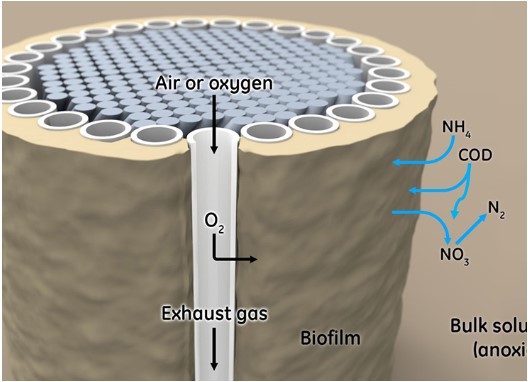Partial Nitritation / Anammox Membrane Aerated Biofilm Reactor (MABR) for Mainstream Nitrogen Removal
Faculty advisor: Glen T. Daigger, Nancy G. Love
PhD student: Brett Wagner

The membrane aerated biofilm reactor (MABR) is a relatively new technology that can accomplish aerobic wastewater treatment at a 50% lower energy demand than conventional secondary treatment. To do this, gaseous oxygen diffuses through a gas-permeable membrane to a biofilm growing on the membrane’s exterior surface. If the partial nitritation-anammox (PN/A) shortcut pathway is used for nitrogen removal, the oxygen demand for the biofilm is 60% less than the nitrification-denitrification pathway, and the organic carbon demand is reduced by 90% which allows water resource recovery facilities to focus on carbon capture during secondary treatment rather than using it for conventional heterotrophic denitrification. Thus, combining PN/A with MABRs offers the potential to, not only significantly reduce the process oxygen demand for nitrogen removal, but to also further improve resource efficiency by freeing up carbon for other uses. These advantages provide the motivation to evaluate the potential for such an approach to mainstream biological nitrogen removal.
Startup of PN/A reactors is commonly difficult because operators must deal with bacterial competition for nitrite between anammox and nitrite oxidizing bacteria (NOBs). Many NOB suppression strategies have proven effective for sidestream applications, including using free ammonia inhibition, free nitrous acid inhibition, and transient anoxia – the latter also for mainstream applications. We are researching how to optimize the MABR startup to encourage anammox growth while also limiting NOB activity.
Contact: [email protected]
